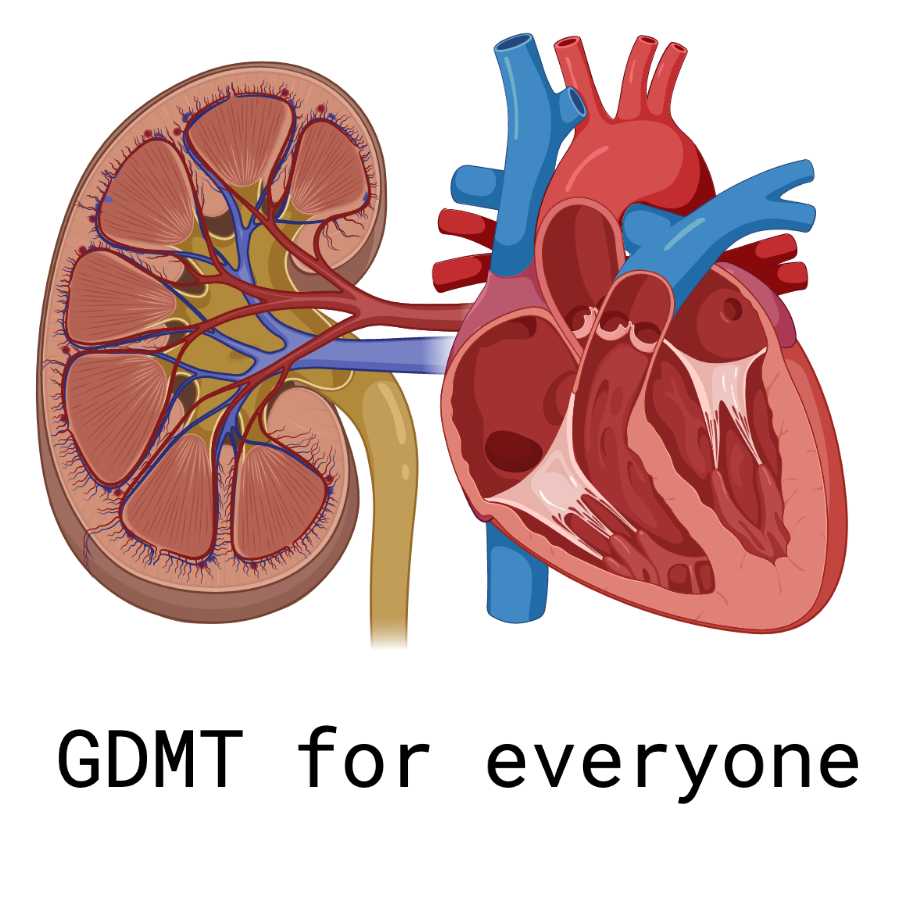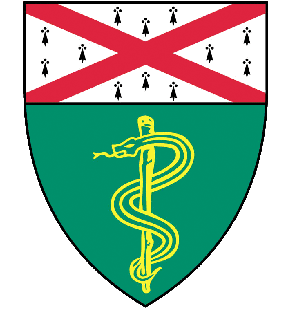GDMT Across the Span of Kidney Disease
Contest Video
Designed for the AHA Council on KCVD
Role of the Kidney in Cardiovascular Disease Educational Tools Contest

Jiawei Tan, MD
Internal Medicine Resident
Yale New Haven-Bridgeport Hospital
Bridgeport, CT

Jiun-Ruey Hu, MD, MPH
Cardiology Fellow
Yale School of Medicine
New Haven, CT
Problem Being Addressed by Educational Tool
Guideline-directed medical therapies (GDMT) are under-prescribed in heart failure with reduced ejection fraction (HFrEF) patients who have concomitant chronic kidney disease (CKD) or end-stage kidney disease (ESKD) in both the inpatient and outpatient settings1,2, despite the established benefit of GDMT in reducing cardiovascular mortality, all-cause mortality, and heart failure (HF) hospitalization3. HF patients with CKD or ESKD are faced with triple threats to their prognosis. First, kidney disease of any stage already portends independent additional risk for mortality in HF after adjustment for covariates4. Second, patients with CKD/ESKD are excluded from over half of randomized controlled trials (RCTs) in cardiology5. Third, patients with CKD/ESKD are significantly less likely to receive GDMT medications approved for their stage of kidney disease due to clinician uncertainty. A post-hoc analysis of GWTG-HF (Get With The Guidelines-Heart Failure) found that triple therapy GDMT (the analysis was done preceding the era of quadruple therapy GDMT) was prescribed in only 33% of CKD 2, 25% of CKD 3a, 15% of CKD 3b, 5% of CKD 4-5, and 3% of ESKD patients with HF6.
Feasibility of Implementation
While it is often assumed that the barrier to GDMT intensification is patient intolerance, the closely-monitored GUIDE-IT trial showed that medication adjustments were only made in 54.6% of qualified visits, reflecting a “therapeutic inertia”7. Presence of CKD was one of the main factors associated with inadequate GDMT prescription8 and uptitration9 in the CHAMP-HF registry. Presence of CKD was the most common reason for not uptitrating GDMT in the BIOSTAT-CHF cohort10. QUALIFY, the international longitudinal registry of HFrEF patients, demonstrated that higher physician adherence scores to GDMT was associated with reduced all-cause mortality, cardiovascular mortality, and HF mortality11. For these reasons, we sought to design an educational tool for the KCVD Council contest to improve uptake of GDMT in patients with CKD or ESKD.
Description of Tool and Plan for Development
Table 1: Gantt chart of feature development accomplished to date. Numbers 1-5 denote week of the month.

Figure 1: Point-of-care summary of core HFrEF GDMT safety across CKD stages/ESKD

Figure 2: Accessing any cell in Figure 1 will trigger modal boxes with direct excerpts from KDIGO, KDOQI, ACC, AHA, or HFSA guidelines to support use or disuse of each agent at each stage of CKD/ESKD

Click this button to try the live prototype at GDMT.org
Figure 3: "Interactive consult" in which tailored recommendations are provided based on clinical inputs

Click this button to try the live prototype at GDMT.org
Table 3: Projected timeline for development of tool

Table 4: Projected two-year budget for development of tool

Dissemination Plan to the Community
If selected, we hope to have the opportunity to deliver a 30 min or 60 min workshop at AHA and ASN to give a “live demo” of how this educational tool can be used in a clinical setting, so that clinicians can bring it back to their home institutions. We also hope to have the opportunity to write a manuscript in any journal as deemed appropriate by the Judges to detail the logic behind the code for the “Interactive Consult”. We will provide our code to journal editors for peer review. In addition, we will work with the KCVD Council to use the appropriate Twitter tags and visual abstract elements to disseminate this educational tool on social media.
Click this button to try the live prototype at GDMT.org
References
1. Heywood JT, Fonarow GC, Yancy CW, et al. Influence of Renal Function on the Use of Guideline-Recommended Therapies for Patients With Heart Failure. The American Journal of Cardiology. 2010-04-01 2010;105(8):1140-1146. doi:10.1016/j.amjcard.2009.12.016
2. Patel UD, Hernandez AF, Liang L, et al. Quality of care and outcomes among patients with heart failure and chronic kidney disease: A Get With the Guidelines—Heart Failure Program study. American Heart Journal. 2008-10-01 2008;156(4):674-681. doi:10.1016/j.ahj.2008.05.028
3. Heidenreich PA, Bozkurt B, Aguilar D, et al. 2022 AHA/ACC/HFSA Guideline for the Management of Heart Failure: A Report of the American College of Cardiology/American Heart Association Joint Committee on Clinical Practice Guidelines. Circulation. 2022-04-01 2022;doi:10.1161/cir.0000000000001063
4. Damman K, Valente MAE, Voors AA, O'Connor CM, Van Veldhuisen DJ, Hillege HL. Renal impairment, worsening renal function, and outcome in patients with heart failure: an updated meta-analysis. European Heart Journal. 2014-02-01 2014;35(7):455-469. doi:10.1093/eurheartj/eht386
5. Konstantinidis I, Nadkarni GN, Yacoub R, et al. Representation of Patients With Kidney Disease in Trials of Cardiovascular Interventions. JAMA Internal Medicine. 2016-01-01 2016;176(1):121. doi:10.1001/jamainternmed.2015.6102
6. Patel RB, Fonarow GC, Greene SJ, et al. Kidney Function and Outcomes in Patients Hospitalized With Heart Failure. Journal of the American College of Cardiology. 2021-07-01 2021;78(4):330-343. doi:10.1016/j.jacc.2021.05.002
7. Fiuzat M, Ezekowitz J, Alemayehu W, et al. Assessment of Limitations to Optimization of Guideline-Directed Medical Therapy in Heart Failure From the GUIDE-IT Trial. JAMA Cardiology. 2020-07-01 2020;5(7):757. doi:10.1001/jamacardio.2020.0640
8. Greene SJ, Butler J, Albert NM, et al. Medical Therapy for Heart Failure With Reduced Ejection Fraction. Journal of the American College of Cardiology. 2018-07-01 2018;72(4):351-366. doi:10.1016/j.jacc.2018.04.070
9. Greene SJ, Fonarow GC, Devore AD, et al. Titration of Medical Therapy for Heart Failure With Reduced Ejection Fraction. Journal of the American College of Cardiology. 2019-05-01 2019;73(19):2365-2383. doi:10.1016/j.jacc.2019.02.015
10. Ouwerkerk W, Voors AA, Anker SD, et al. Determinants and clinical outcome of uptitration of ACE-inhibitors and beta-blockers in patients with heart failure: a prospective European study. European Heart Journal. 2017-06-21 2017;38(24):1883-1890. doi:10.1093/eurheartj/ehx026
11. Komajda M, Cowie MR, Tavazzi L, Ponikowski P, Anker SD, Filippatos GS. Physicians' guideline adherence is associated with better prognosis in outpatients with heart failure with reduced ejection fraction: the QUALIFY international registry. European Journal of Heart Failure. 2017-11-01 2017;19(11):1414-1423. doi:10.1002/ejhf.887


Yale School of Medicine